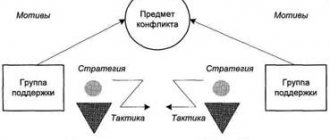Concepts of conflict typology
Definition 1
Conflict is a typical form of social interaction and is characterized by the following features:
- Interaction occurs between two or more entities.
- Subjects have conflicting interests, which are resolved in the form of open confrontation.
Representing a form of social interaction, conflict is primarily considered as an object of typology. The criteria for dividing conflicts into groups can be a variety of factors, for example, time, the composition of the subjects involved in the conflict, the field of activity in which the conflict arose, the direction of the conflict, etc.
Figure 1. Typology of conflicts. Author24 - online exchange of student work
Are you an expert in this subject area? We invite you to become the author of the Directory Working Conditions
Bibliography
1. Conflictology: textbook for universities / ed. prof. V.P. Ratnikova. – M.: UNITY-DANA, 2011.
2. Psychology and ethics of business communication: a textbook for university students / ed. V.N. Lavrinenko. – 5th ed. – M.: UNITY-DANA, 2008.
3. Educational resources // Financial University under the Government of the Russian Federation. – URL: . Access by login and password.
4. Single window of access to educational resources": [Electronic library]. – URL: https://window.edu.ru. Access is free.
5. Electronic library system of INFRA-M Publishing House LLC (access through the online repository of educational resources of ZFEI).
– URL: . Access by login and password.
Examples of similar educational works
Conflict resolution involving a third party
... constructive and destructive conflicts. Constructive conflicts are characterized by disagreements that affect fundamental parties, problems of the life of the organization and its members, and the resolution of which takes the organization to a new, more...
Conflict management technologies in modern organizations
... conflict resolution in the enterprise; 5) develop recommendations for reducing conflict in the analyzed unit. The experimental basis for this thesis research was the organization ... the other side of the opportunity to achieve your goals. Conflicts...
Conflict management in modern organizations
... goals, information and behavioral attitudes. Conflict in an organization is a problem of the internal environment that arises ... working time to resolve various types of conflicts. Every manager needs to know about conflicts, methods of behavior in...
Conflicts in tourism organizations
...or more parties. Nowhere are conflicts more evident than in the world of business. There are conflicts between firms, companies, associations, within the same organization, etc. A conflict that arises in an organization is called organizational. ...
25.Professional guidance: concept, purpose, types. Professional Consulting
... the goals of the organization and its mission. Every employee should know these goals because, ... goals are presented in Fig. 1. Needs Goals Behavior Motives Incentives Result of satisfaction Fig. 1. Scheme of the motivational process Example: there arises...
Criteria for typologizing conflicts
There are various criteria for typologizing a conflict, which can be multidirectional. Let's consider the main classifications of conflicts:
By subject composition:
- Interpersonal - arise in everyday life, between spouses, between parents and children, etc.
- Intergroup - arise in the sphere of interethnic and interfaith agreements, as wars between states, etc.
- With a complex subject composition - for example, when a person acts as one subject, and an educational institution or organization acts as another subject.
Based on intent:
- Planned conflicts. This type of conflict is characterized by the presence of intent to create a conflict, thinking through the tactics of one’s behavior, initiating a conflict, provoking the subject. For example, terrorist attacks that involve hostage-taking can be considered as a similar type of conflict. When terrorists take hostages, they thus provoke the authorities to take certain actions, to fulfill the terrorists’ demands.
- Natural conflicts. These types of conflicts are associated with mass unrest and quite often arise in places where there are large concentrations of people. For example, at football matches, rock band concerts, rallies, etc. The specificity of this type of conflict is that the subject of the conflict is an unorganized mass, a crowd. When people are in a crowd, their behavior is subject to the principle of conformism, that is, the person seems to dissolve in the crowd and ceases to perceive himself and those around him as an independent person. Often, a spontaneous conflict is the result of provocative actions, which can also be intentional or unintentional.
Finished works on a similar topic
Course work Typologization of conflicts 460 ₽ Abstract Typologization of conflicts 280 ₽ Test work Typologization of conflicts 240 ₽
Receive completed work or specialist advice on your educational project Find out the cost
In the area of conflict interaction:
- within a social group;
- between social groups.
An important factor in the typology of conflicts are also the areas of conflict interaction. For example, conflicts can arise between local systems, as well as between structural elements of systems. Conflicts that arise within systems are caused by contradictions that arise within the system itself. Such conflicts may include conflicts between spouses, between parents and children, employees and employers, etc.
To realize the needs that served as a prerequisite for the conflict:
- Material – it is necessary to satisfy material needs, which is determined by the desire to have material resources, money, certain life benefits, for example, a house, car, telephone, etc.
- Status-role. A person wants to get a certain role in society, for example, to become a spouse, to occupy a certain position, to gain authority in a certain social group. However, often the interests of people regarding the distribution of status roles coincide, and a conflict of interests arises.
By direction:
- Horizontal - arise between business partners, colleagues, co-workers, etc.
- Vertical - arise between the leader and subordinates.
According to time parameters:
- Short-term – lasting for a relatively short period of time.
- Fleeting - developing quickly and rapidly.
- Long-term – these types of conflicts can last for years, and sometimes decades. Basically, these types of conflicts include state, national, and religious conflicts.
According to performance criteria:
- Constructive, that is, normal, positive. When constructive conflicts arise, the groups within which they occur retain their integrity, and interaction is established between the subjects.
- Destructive or pathological, negative. The relationship between people during this conflict takes on negative forms, the nature of the conflict leads to the destruction and disintegration of the organization and relationships between people.
Table 1 Horizontal and vertical conflicts
| Conflict type | The way the conflict manifests itself | ||
| Horizontally | Vertically" | ||
| "down up" | "top down" | ||
| Obstacles to achieving the main goals of joint work activities | The actions of one interfere with the successful activities of the other. Organizational conflict. | The manager does not provide subordinates with the opportunity to successfully achieve the goal of the activity | The subordinate does not provide the manager with the opportunity to fulfill the main goal of the activity |
| Obstacles to achieving the goals of joint work activities | The actions of one interfere with the achievement of the personal goals of others. Organizational conflict. | The manager does not provide the subordinate with the opportunity to achieve personal goals | The subordinate creates obstacles for the manager to achieve personal goals |
| Contradiction of actions with accepted norms | Conflict of group norms | Contradictions between a leader’s activities and his work style | The activities of a subordinate as a bearer of a certain social role contradict the expectations of the manager |
| Personal conflicts | Personal incompatibility | Leaders and influencers fail to meet followers' expectations | Team members do not live up to the expectations of their leaders and authorities |
Ways to resolve different types of conflicts
Types of planning by form, timing and directions, its functions
There are several types of conflict resolution. In practice, this occurs as the replacement of destructive behavioral patterns with constructive ones. A competent solution to the conflict will eliminate the causes of the confrontation:
- Permission. This method is suitable if all participants are committed to completely solving and eliminating the problem.
- Settlement. Both sides are actively involved in resolving the current situation. The presence of a third independent person is assumed.
- Attenuation. Cessation of opposition while maintaining tension.
- Elimination. It is assumed that the provoking conditions will be eliminated.
- Transformation. There is a change in the object of disagreement, as well as the motives.
In order to completely resolve the conflict and prevent a repetition of the situation, it is necessary to bring the resolution of all types and types of conflicts to the end. Conflict situations at school are an inevitable and complex phenomenon; they require resolution without traumatizing the child’s psyche. As a striking example, the struggle for leadership between students of the same class, when an “anti-leader” is automatically selected for constant bullying and bullying. In social studies lessons, the topic of social conflicts is studied so that schoolchildren can navigate correctly in adult life.
There are methods for relieving tension and preventing all types of conflict situations:
- Passion for a common cause that will meet the interests of both parties.
- Developing the ability to empathize.
- Formation of respect and understanding of each individual.
- Organization of holidays, joint recreation to relieve psychological stress.
- Completing trainings and courses on developing and strengthening interpersonal relationships.
Conflict resolution
Preventing conflicts in a team requires constant practice. To manage organizational conflicts according to all the rules of management, it is necessary to determine the type and causes, their characteristics and find the correct method of resolution.
Signs and types of conflicts
Not every contradiction can be called a conflict. It is usually accompanied by negative emotions and is aimed at resolving clashes caused by contradictions in views, interests, and values.
Main features
In order to distinguish a conflict from ordinary quarrels, it is important to know its main signs. These include:
The presence of two sides with opposing views and opposition for each of them. If opinions coincide, there can be no struggle. Even if the conflict is intrapersonal, the person contradicts himself and cannot make the only right decision.- Activity of both sides. A conflict is impossible without a reason, a special impulse that would give impetus to the aggravation of relations. It is caused by one of the parties, and the other reacts and provokes retaliatory actions. Both people or groups of people have their own interests, which they are ready to defend to the last.
Types of conflicts and their characteristics
A large number of conflicts can be identified in a variety of categories. Scheme of the conflict by duration - depending on the time during which contradictions arise and ways to resolve them are found:
- Long-term. Such conflicts do not arise immediately; the ground for them is prepared for many years. For example, World War II. Relations between European countries and Germany quickly became tense; Hitler, not by magic, wanted to conquer the whole world and assembled a powerful army. That is why such contradictions take the longest to resolve. The most difficult thing in long-term conflicts is to find its true cause, and not try to fight what lies on the surface.
- Short term. Most often these are ordinary quarrels that happen every day. Friends can't decide what game to play in the yard, and mom is outraged that her son hasn't washed the dishes again. Such conflicts are resolved quickly and do not have dangerous consequences, unless their cause is so serious that it develops into something more.
- Lingering. Not as long as the first category , since their reason is much simpler. For example, a conflict between a goth daughter and a mother who does not understand her lifestyle and habits.
- Repetitive. Something that makes itself felt again and again. A child regularly stays out until late, for which he receives a scolding from his parents, or an employee who is systematically late and listens to instructions from management every day.
Conflicts can be divided by volume - what scale this or that conflict affects, how many people, groups, associations it affects. The following types are distinguished:
- Global. Affect the whole world or several countries. These are the well-known World Wars, of which there have already been two in human memory, the invasion of Batu Khan in the thirteenth century, conflicts in Syria and Iraq. Not only the military and residents of captured cities suffer from these conflicts, but also the rest of the world: the economy is collapsing, people are starving and do not feel protected.
- Local. Conflicts that affect two or three states and have little to do with the rest of the world . An example is the collapse of the USSR, when contradictions concerned only the union republics, or the clash between Russia and Ukraine over Crimea.
- Regional. As a rule, they occur within one state. They can be expressed in dissatisfaction with the government, the current structure, social status and level of the economy.
It is not necessary for those involved in a conflict to take direct part in it. They can relate to what is happening only indirectly. Conflicts are also divided according to the form they occur:
- Internal. Conflicts that affect representatives of one class (conflict between representatives of the political elite of the state), one species (the struggle for survival among animals).
- External. Directly affect participants from different segments of the population, classes, species. This includes the eternal confrontation between the poor and the rich, liberals and democrats, fathers and children. Each of them defends their own views and beliefs, which very often contradict each other.
To resolve a conflict, it is important to consider what environment it affects and what values it concerns. Classification of conflicts - table of division by spheres of public life:
- Economic. Most often, clashes concern property rights and material well-being. People who have spent their whole lives in poverty are trying to escape and improve their situation, however, it is difficult for them to get a well-paid job and radically change the situation.
- Social. They arise not only between representatives of different classes, but also between an individual and society. All people from birth have social statuses and roles that are acquired or changed throughout their lives. When a person does not meet the expectations of others or behaves immorally, social conflict arises.
- Political. One of the largest and most long-lasting. Among the safest are discord within political parties and the struggle of elites within one state. An example is the constant confrontation between Democrats and Republicans, conservatives and liberals. The most dangerous political conflicts are reaching the global level. This includes sanctions against Russia imposed by European states.
- Ethnic. Collision of interests of representatives of different ethnic groups . For example, within one state several ethnic groups have developed with their own traditions and history. They want to be independent, but the state's policy is aimed at subordinating their culture to the dominant one and taking control.
- Religious. The struggle between Orthodox and Catholics, Muslims and Christians.
Another typology of conflicts is a table of division by the number of participants. Even if a person comes into conflict with himself, we can talk about the presence of two sides. There would be no conflict if a person steadfastly adhered to the same point of view and the same values. The following types are distinguished:
- Intrapersonal. The problem is within a person, between who he wants to be and who he really is. Every person at least once began to doubt his abilities and demanded from himself something that he could hardly cope with. Most likely, this caused internal dissonance and decreased self-esteem and even depression. To avoid such situations, it is important to soberly assess your capabilities and compare them with your dreams. Of course, it is stupid to expect that a girl suffering from excess weight will suddenly pass a difficult physical education test with excellent marks, no matter how hard she tries. Such contradictions can act as a push to become better.
- Interpersonal. Collisions between people in the process of their interaction. Friends didn't share a football match or classmates shared a physics project. In seventy percent, the main cause of interpersonal conflicts is material wealth and the desire to acquire certain resources. Outwardly, this may seem like a discrepancy between interests and moral values, although the real reason, as a rule, lies much deeper. Psychology helps best in resolving them.
- Between the individual and the group. Most often they affect nonconformists , that is, people who disagree with established standards and go against society. They are often misunderstood, and their interests rarely coincide with traditional ones.
- Intergroup. Clashes of interests of various groups are most often generated in the production sphere - the struggle for limited resources or management factors. Several main groups can be distinguished, for example, hard workers and those who like to relax in the workplace, management and performers, and so on.
By spheres of life - depending on the sphere of social relations that they directly affect. Sociologists distinguish the following types:
- Family. Between representatives of one or more families: inheritance issues, division of property during divorce or relocation, misunderstanding of children.
- Labor. Directly affecting the professional sphere. They can be both vertical (when people are not equal in status - boss and subordinate) and horizontal (contradictions between equals - colleagues, comrades).
- Household. Everyday arguments that happen every day.
- Educational and pedagogical. They concern issues of education and training.
Also, conflict situations can be obvious , when both sides take decisive measures and recognize their contradictions, as well as latent, when the dissatisfaction of one side with the other is hidden and hardly manifests itself.









